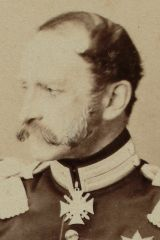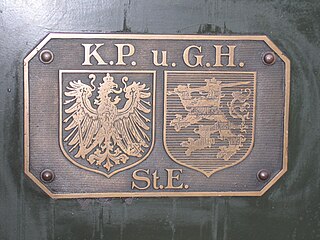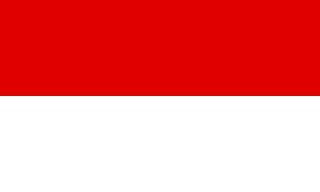Related Research Articles

A Landtag is generally the legislative assembly or parliament of a federated state or other subnational self-governing entity in German-speaking nations. It is usually a unicameral assembly exercising legislative competence in non-federal matters.

The Confederated States of the Rhine, simply known as the Confederation of the Rhine, also known as Napoleonic Germany, was a confederation of German client states established at the behest of Napoleon some months after he defeated Austria and Russia at the Battle of Austerlitz. Its creation brought about the dissolution of the Holy Roman Empire shortly afterward. The Confederation of the Rhine lasted from 1806 to 1813.

Saxe-Weimar-Eisenach was a historical German state, created as a duchy in 1809 by the merger of the Ernestine duchies of Saxe-Weimar and Saxe-Eisenach, which had been in personal union since 1741. It was raised to a grand duchy in 1815 by resolution of the Vienna Congress. In 1903, it officially changed its name to the Grand Duchy of Saxony, but this name was rarely used. The Grand Duchy came to an end in the German Revolution of 1918–19 with the other monarchies of the German Empire. It was succeeded by the Free State of Saxe-Weimar-Eisenach, which was merged into the new state of Thuringia two years later.

The Duchy of Nassau was an independent state between 1806 and 1866, located in what is now the German states of Rhineland-Palatinate and Hesse. It was a member of the Confederation of the Rhine and later of the German Confederation. Its ruling dynasty, now extinct, was the House of Nassau. The duchy was named for its historical core city, Nassau, although Wiesbaden rather than Nassau was its capital. In 1865, the Duchy of Nassau had 465,636 inhabitants. After being occupied and annexed into the Kingdom of Prussia in 1866 following the Austro-Prussian War, it was incorporated into the Province of Hesse-Nassau. The area today is a geographical and historical region, Nassau, and Nassau is also the name of the Nassau Nature Park within the borders of the former duchy.

Lich is a town in the district of Gießen, in Hesse, Germany. It is situated 12 km southeast of Gießen. Lich has a population of around 13,000.

The Grand Duchy of Hesse and by Rhine was a grand duchy in western Germany that existed from 1806 to 1918. The grand duchy originally formed on the basis of the Landgraviate of Hesse-Darmstadt in 1806 as the Grand Duchy of Hesse. After the end of the Napoleonic Wars in 1815, it changed its name in 1816 to distinguish itself from the Electorate of Hesse, which had formed from neighboring Hesse-Kassel. Colloquially, the grand duchy continued to be known by its former name of Hesse-Darmstadt. It joined the German Empire in 1871 and became a republic following the empire's fall after World War I in 1918.

Prince Charles of Hesse and by Rhine was a German prince, officer and politician. He was the second surviving son of Louis II, Grand Duke of Hesse and Wilhelmine of Baden. The prince had a military career and became a general in the infantry of the army of the Grand Duchy of Hesse. He was also a member of the Landtag of Hesse.
The politics of Hesse takes place within a framework of a federal parliamentary representative democratic republic, where the Federal Government of Germany exercises sovereign rights with certain powers reserved to the states of Germany including Hesse. The state has a multi-party system where, as in most other states of former Western Germany and the federal level, the two main parties are the centre-right Christian Democratic Union (CDU) and the centre-left Social Democratic Party of Germany (SPD).

The Landtag of Hesse is the unicameral parliament of the State of Hesse in the Federal Republic of Germany. It convenes in the Stadtschloss in Wiesbaden. As a legislature it is responsible for passing laws at the state level and enacting the budget. Its most important function is to elect and control the state government. The constitution of the State of Hesse describes the role of the Landtag in sections 75 to 99.

The Royal Prussian and Grand-Ducal Hessian State Railways was a state-owned network of independent railway divisions in the German states of Prussia and Hesse in the early 20th century. It was not, as sometimes maintained, a single state railway company.

The civil flag of Hesse consists of a bicolor of a red top and a bottom white stripe, in the proportion 3:5. The state flag is similar, except it is emblazoned with the state coat of arms in the centre, and may only be used by government departments and services.
The Estates of Württemberg was the Estates of the Duchy of Württemberg, lasting from 1457 to 1918 except for 1802-15. After the creation of the Kingdom of Württemberg the 1815 reestablished estates became a bicameral parliament by 1819.
Prince Charles Ferdinand William of Solms-Lich-Hohensolms was a German politician. He was president of the First Chamber of the Estates of the Grand Duchy of Hesse.

The Prussian State Council was the upper chamber of the bicameral legislature of the Free State of Prussia between 1920 and 1933. The lower chamber was the Prussian Landtag.

Wiesbaden City Palace is a neo-classical building in the center of Wiesbaden, Germany. It was completed in 1841 as the principal city residence of the Dukes of Nassau. The palace has several wings, 145 rooms, and is architecturally integrated with a group of ancillary buildings constructed both before and after it was built. With ornate towers, gables and a slate roof laid in herringbone patterns, the three-story complex lends charm and its name to the central square of Wiesbaden: Palace Square.

Count Karl von Schlitz, in full: Karl Heinrich Wilhelm Hermann Ferdinand von Schlitz, genannt von Görtz was a German politician and Standesherr in the Grand Duchy of Hesse.
References
- ↑ Friedrich, Karl: Adelung, Bernhard in Neue Deutsche Biographie
- ↑ Ruppel, Hans Georg and Groß, Birgit: Heßische Abgeordnete 1820-1930, Verlag des historische Vereins für Hessen, Darmstadt 1980 ISBN 3-922316-14-X (Darmstädter Archivschrifte 5)
- ↑ "Hessischer Landtag". Archived from the original on 2011-03-15. Retrieved 2020-03-04.